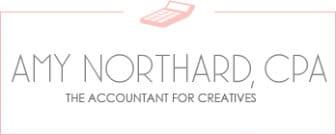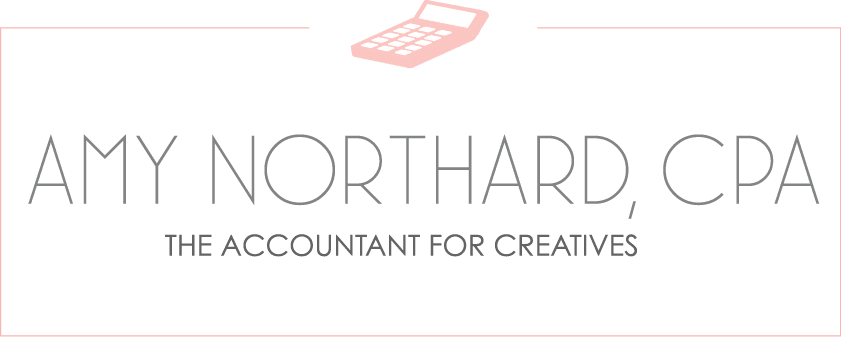When you’re starting a new business, everything is already overwhelming enough—forget having to fill out new and unfamiliar forms come tax time!
And the Schedule C can look like a doozy, but I promise, it’s not that difficult (especially if you’ve been staying on top of your accounting throughout the year).
First, let’s quickly make sure you’re filling out the correct form. The Schedule C is meant for Sole Proprietors who have made $400 or more in gross income from their business that year. If you’re using any other type of business structure—like an LLC or partnership—you may need different forms to file your taxes.
Now, let’s dig into exactly what you’re reporting to the IRS on Schedule C.
Give Them the Basic Info About Your Business
Before we get into the numbers, you have to let the IRS know who you are and what your business is. Most of this information should be pretty self explanatory, but there are a few spots that occasionally trip people up:
- Line A: Asks for information on your principal business—basically, what does your business do? Don’t make this too complicated, just give the elevator pitch version of the general field or activity of your business, like “freelance writing” or “wedding photography.” If you have several distinct lines of business that you’ve made money from, you’ll need to file a separate Schedule C for each one. For instance, while doing graphic design and copywriting for websites could be combined into one business (and filed together) a bakery and a graphic design business would need two separate forms.
- Line B: Asks for the employer code for your principal business—you can find these codes on the last two pages of the Schedule C instructions. Choosing which code best applies to your business can take a bit of creativity because, frankly, the list is a bit out of date when it comes to today’s careers. Do your best to find the industry that feels most related, and don’t fret over this too much; the IRS uses this to track the growth of different industries, so you won’t be dinged for getting it “wrong.”
- Line D: Asks for your Employer ID number (EIN). You might not have one of these, and that’s fine! If you have one, fill it in here in addition to your SSN above. If not, just your SSN will suffice. More on deciding if you need an EIN (and how to create one) here!
- Line F: Asks you to specify your accounting style. You should choose cash or accrual from the start of your business, and ideally stick to it as changing down the road is a bit of a pain. Many small business owners choose cash accounting since it only makes them pay taxes on the money they actually have in their bank accounts. More on the difference between cash and accrual accounting and how to choose here!
- Line G: Asks if you “materially participated” in the business during this tax year. Basically, did you do work on it or was it complete passive income? Most creative entrepreneurs will answer yes to this question unless they are, for instance, making money from a book or online class they released years ago and are no longer working on. Another common reason you might answer “no” to this question is if your business is a rental property. If you worked your butt off for your business, this is an obvious yes—if you’re unsure, read the full rundown of how the IRS determines material participation here or chat with a CPA.
- Lines I & J: Ask about whether you filed 1099s, which is required if you paid any independent contractors over $600 via cash, check, or bank transfer throughout the course of the year. More on the rules around 1099s here.
Calculate Your Gross Income for the Year
Up next, you’re going to tell the IRS all about the cash money you made, and they really walk you through the math here so it should be pretty easy if you’ve been tracking your sales well.
You’ll start with your gross receipts or sales (Line 1), which is basically all of the money you charged people for, not accounting for the cost of making it. This includes money from invoices you sent out, sales you made, or any 1099s that you received from working as an independent contractor for another business.
Then you’ll subtract any refunds you gave throughout the year (Lines 2 & 3) and your cost of goods sold (Lines 4 & 5). At this point, you’ll want to jump down to Part III of the form to calculate your COGS.
Finally, you add any additional income (like from interest on a business banking account or bad debt you recovered) on Line 6 and end up with your gross income!
Account for Your Expenses
Now we get into how much it cost you to make that money. While this section has a lot of fields and can look overwhelming, again, it shouldn’t be too hard if you’ve done a good job of tracking your expenses all year.
Start by tackling Lines 8-27, which have you break down all your business expenses by category, reporting on everything except business use of your home, which comes later. If you’re not sure whether something counts as a business expense for this section, check out my full rundown of tax deductions for small business owners here!
Most are pretty straightforward: Tally your receipts, put the number in the box, and you’re done. However, for claiming depreciation and amortization on Line 13, you may need to also attach Form 4562 if you had a business asset that’s $2,500 or greater and are claiming depreciation expense for that asset, or have depreciation from prior years that you haven’t fully expensed. More on depreciation here.
If you’re deducting expenses from the use of your car for business on Line 9 and didn’t have to file Form 4562 (which accounts for automobile use), you’ll want to jump down to Section IV to give information about how you use your vehicle for work. This includes the exact mileage you used for business purposes, which you’ll need evidence of, so you shouldn’t guess. More on deducting car and truck expenses here.
There’s also a section at the bottom of Schedule C (Part V) for detailing other expenses that didn’t fit into any of the listed categories. This might include things like software subscriptions or costs, business use of a cell phone, or education costs.
Then, on Line 30, you’ll dig into expenses from business use of your home, using either the Simplified Method Worksheet on page 11 of the Schedule C instructions or Form 8829 to calculate that number.
Add all these expenses up and subtract them from your gross income to figure out your net profit (or loss) on Line 31.
Once all is said and done, you’ll put this number onto your Schedule 1 (Form 1040) on Line 12 and on your Schedule SE on Line 2. If you did take a loss, you’ll need to let the IRS know if you are personally at risk of losing all the money if the business fails, or if there’s outside investment preventing you from actually losing all the money. Most self-employed people will mark that it’s at-risk because they’ve put up the funds needed to run their business.
I know—it feels like a lot. But I promise, you CAN do it. And if you are feeling overwhelmed (or just don’t want to take the time or energy to figure it out), know that there are plenty of CPAs like me who are happy to do the dirty work for you.

